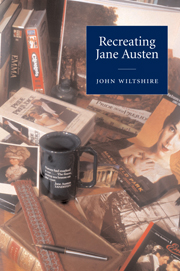Book contents
- Frontmatter
- Contents
- Preface and acknowledgments
- A note on texts
- Introduction: ‘Jane Austen’ and Jane Austen
- 1 Imagining Jane Austen's life
- 2 Recreating Jane Austen: Jane Austen in Manhattan, Metropolitan, Clueless
- 3 An Englishwoman's constitution: Jane Austen and Shakespeare
- 4 From drama, to novel, to film: inwardness in Mansfield Park and Persuasion
- 5 Pride and Prejudice, love and recognition
- 6 The genius and the facilitating environment
- Notes
- A note on films cited
- Bibliography
- Index
1 - Imagining Jane Austen's life
Published online by Cambridge University Press: 22 September 2009
- Frontmatter
- Contents
- Preface and acknowledgments
- A note on texts
- Introduction: ‘Jane Austen’ and Jane Austen
- 1 Imagining Jane Austen's life
- 2 Recreating Jane Austen: Jane Austen in Manhattan, Metropolitan, Clueless
- 3 An Englishwoman's constitution: Jane Austen and Shakespeare
- 4 From drama, to novel, to film: inwardness in Mansfield Park and Persuasion
- 5 Pride and Prejudice, love and recognition
- 6 The genius and the facilitating environment
- Notes
- A note on films cited
- Bibliography
- Index
Summary
We are divided of course between liking to feel the past strange and liking to feel it familiar; the difficulty is, for intensity, to catch it at the moment when the scales of the balance hang with the right evenness.
Henry James, Preface to The Aspern PapersConstance Pilgrim's wonderful, ridiculous book Dear Jane: a Biographical Study was first published in 1971, and reissued twenty years later. It tells a story that is mentioned in all lives of the novelist. When she was very old Cassandra Austen recalled that she and her sister had met a personable young man on holiday in Devonshire sometime in the first years of the century. He was attracted to Jane, and the feeling was apparently reciprocated. The Austens expected to hear from him again, arranged even to meet him the next year, but instead the news came of his sudden death. Pilgrim's book concerns this ‘mysterious romance’ and its disappointing denouement. She set herself to uncover the identity of Jane Austen's admirer, with remarkable results.
Like many biographers, Constance Pilgrim's main source for information about the novelist's emotional life is the novels themselves. Assuming that the air of reality which so many passages convey indicates their origin in autobiographical experience, and especially, as an acquaintance of Jane Austen claimed, that ‘Anne Elliot was’ the novelist herself, and moreover (as a scrap of reminiscence suggests) the young man was a naval officer, one obvious candidate presents himself irresistibly to the biographer's mind.
- Type
- Chapter
- Information
- Recreating Jane Austen , pp. 13 - 37Publisher: Cambridge University PressPrint publication year: 2001

